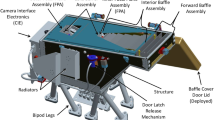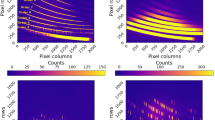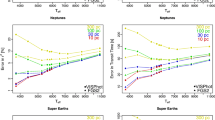Abstract
The “TNOs are Cool!: A survey of the trans-Neptunian region” is a Herschel Open Time Key Program that aims to characterize planetary bodies at the outskirts of the Solar System using PACS and SPIRE data, mostly taken as scan-maps. In this paper we summarize our PACS data reduction scheme that uses a modified version of the standard pipeline for basic data reduction, optimized for faint, moving targets. Due to the low flux density of our targets the observations are confusion noise limited or at least often affected by bright nearby background sources at 100 and 160 \(\mu \)m. To overcome these problems we developed techniques to characterize and eliminate the background at the positions of our targets and a background matching technique to compensate for pointing errors. We derive a variety of maps as science data products that are used depending on the source flux and background levels and the scientific purpose. Our techniques are also applicable to a wealth of other Herschel solar system photometric observations, e.g. comets and near-Earth asteroids. The principles of our observing strategies and reduction techniques for moving targets will also be applicable for similar surveys of future infrared space projects.




Similar content being viewed by others
Notes
Asteroids Dynamic Site by A. Milani, Z. Knezevic, O. Arratia et al., http://hamilton.dm.unipi.it/astdys/, calculations based on the OrbFit software.
Targets: 42355 Typhon (two observations), 79360 Sila, 82075 (2000 YW\(_{134}\)), 126154 (2001 YH\(_{140}\)) and 208996 (2003 AZ\(_{84}\)).
Target 136472 Makemake (two observations).
For details, see the PACS Data Reduction Guide: http://herschel.esac.esa.int/twiki/bin/viewfile/Public/PacsCalibrationWeb?rev=1;filename=PDRG_Dec2011.pdf.
Interactive Data Language, Research Systems Inc.
Well, this is not exactly half. The two negative beams contain the half flux of the first and second visits separately, which is half the co-added DDIFF flux only if the flux of the target has not changed between the two visits.
References
Balog, Z., Müller, T.G., Nielbock, M., et al.: The Herschel-PACS photometer calibration: point-source flux calibration. Exp. Astron. this issue (2013)
Duffard, R., Pinilla-Alonso, N., Santos-Sanz, P., et al.: TNOs are Cool: A Survey of the transneptunian region: A Herschel-PACSview of 16 centaurs. Astron. Astrophys. submitted (2013). arXiv:http://arxiv.org/abs/1309.0946, (2013)
Fornasier, S., Lellouch, E., M¨uller, T., et al.: TNOs are cool: A survey of the trans-neptunian region. VIII. Combined Herschel PACS and SPIRE observations of 9 bright targets at 70–500 μm. Astron. Astrophys. 555, A15 (2013)
Gordon, K.D., Engelbracht, C.W., Fadda, D.: Absolute calibration and characterization of the multiband imaging photometer for Spitzer. II. 70 μm imaging. PASP 119, 1019 (2007)
Griffin, M.J., Abergel, A., Abreu, A., et al.: The Herschel-SPIRE instrument and its in-flight performance. A&A 518, L3 (2010)
Kiss, C., Klaas, U., Lemke, D.: Determination of confusion noise for far-infrared measurements. A&A 430, 343 (2005)
Kiss, C., Vilenius, E., Müller, T.G.: Thermal emission of the eris dysnomia system as observed by Herschel/PACS. In: Proceedings of the Conference Asteroids, Comets, Meteors 2012. LPI Contribution No. 1667, id.6357 (2012)
Kiss, C., Szabó, G., Horner, J., et al: A portrait of the extreme solar system object 2012 DR30. A&A 555, A3 (2013)
Kiss, C., Müller, T.G., Vilenius, E., et al.: The trans-Neptunian objects after Herschel—What could SPICA add to the understanding of the Kuiper belt? In: Proceedings of the SPICA International Science Conference, PV-1 (2013)
Lebofsky, L.A., Sykes, M.V., Tedesco, E.F., et al.: A refined standard thermal model for asteroids based on observations of 1 Ceres and 2 Pallas. Icarus 68, 239 (1986)
Lellouch, E., Kiss, C., Santos-Sanz, P., et al.: TNOs are cool: a survey of the trans-Neptunian region. II. The thermal lightcurve of (136108) Haumea. A&A 518, L147 (2010)
Lellouch, E., Santos-Sanz, P., Lacerda, P.: TNOs are cool: a survey of the trans-Neptunian region. IX. Thermal properties of Kuiper belt objects and centaurs from combined Herschel and Spitzer observations. A&A 557, A60 (2013)
Lim, T.L., Stansberry, J., Müller, T.G., et al.: TNOs are cool: a survey of the trans-Neptunian region. III. Thermophysical properties of 90482 Orcus and 136472 Makemake. A&A 518, L148 (2010)
Mommert, M., Harris, A.W., Kiss, C., et al.: TNOs are cool: a survey of the trans-Neptunian region. V. Physical characterization of 18 Plutinos using Herschel-PACS observations. A&A 541, A93 (2012)
Müller, T.G., Lellouch, E., Böhnhardt, H., et al.: TNOs are cool: a survey of the transneptunian region. EM&P 105, 209 (2009)
Müller, T.G., Lellouch, E., Stansberry, J., et al.: TNOs are cool: a survey of the trans-Neptunian region. I. Results from the Herschel science demonstration phase (SDP). A&A 518, L146 (2010)
Nakagawa, T., Matsuhara, H., Kawakatsu, Y.: The next-generation infrared space telescope SPICA. In: Proceedings of the SPIE, vol. 8442, id. 84420O (2012)
Nielbock, M., Müller, T.G., Balog, Z., et al.: The Herschel-PACS photometer calibration: a time dependent flux calibration for the PACS chopped photometry AOT mode. Exp. Astron. this issue (2013)
O’Rourke, L., Kiss, C., Barucci, A., et al.: Herschel observations of the Hayabusa 2 asteroid 162173 (1999 JU\(_{3}\)). In: European Planetary Science Congress 2012, id.EPSC2012-753 (2012)
Ott, S.: The Herschel data processing system HIPE and pipelines up and running since the start of the mission. In: Mizumoto, Y., Morita, K.-I., Ohishi, M. (eds.) Astronomical Data Analysis Software and Systems XIX, ASP Conference Series, vol. 434, p. 139 (2010)
Pál. A: FITSH- a software package for image processing. MNRAS 421, 1825 (2012)
Pilbratt, G., Reidinger, J.R., Passvogel, T., et al.: Herschel space observatory. An ESA facility for far-infrared and submillimetre astronomy. Astron. Astrophys. 518, L1 (2010)
Poglitsch, A., Waelkens, C., Geis, N., et al.: The Photodetector Array Camera and Spectrometer (PACS) on the Herschel space observatory. A&A 518, L2 (2010)
Popesso, P., Magnelli, B., Buttiglione, S., et al.: The effect of the high-pass filter data reduction technique on the Herschel PACS Photometer PSF and noise, A&A, submitted [arXiv:1211.4257] (2012)
Santos-Sanz, P., Lellouch, E., Fornasier, S., et al.: TNOs are Cool: a survey of the trans-Neptunian region. IV. Size/albedo characterization of 15 scattered disk and detached objects observed with Herschel-PACS. A&A 541, A92 (2012)
Shirahata, M., Matsuura, S., Hasegawa, S.: Calibration and performance of the AKARI Far-Infrared Surveyor(FIS)—slow-scan observation mode for point-sources. PASJ 61, 737 (2009)
Stansberry, J., Grundy, W.M., Brown, M.E., et al.: The Solar System Beyond Neptune, Physical Properties of Kuiper Belt and Centaur Objects: Constraints from the Spitzer Space Telescope, p 161. University Arizona Press, Tuscon (2008)
Vavrek, R., Wetzstein, M., Royer, P.: Multiresolution deglitching routines for Herschel-PACS data. In: Astronomical Data Analysis, vol. 5. Heraklion (2008)
Vilenius, E., Kiss, C., Mommert, M., et al.: TNOs are Cool: a survey of the trans-Neptunian region. VI. Herschel/PACS observations and thermal modeling of 19 classical Kuiper belt objects. A&A 541, A94 (2012)
Acknowledgments
This work has been supported by the Hungarian Research Fund (OTKA) grant K 104607, the PECS-98073 grant of the European Space Agency (ESA) and the Hungarian Space Office and the Bolyai Research Fellowship of the Hungarian Academy of Sciences. E.V. acknowledges the support of the German DLR project # 50 OR 1108. The work of A.P. has been supported by the Lendületgrant # LP2012-31/2012 of the Hungarian Academy of Sciences. We are indebted to the Herschel observation planning team for their enthusiastic work during the active phase of the program which has highly contributed to the great success of the observations. We also thank the referee for providing constructive comments and help in improving this paper.
Author information
Authors and Affiliations
Corresponding author
Additional information
Herschel is an ESA space observatory with science instruments provided by European-led Principal Investigator consortia and with important participation from NASA.
Rights and permissions
About this article
Cite this article
Kiss, C., Müller, T.G., Vilenius, E. et al. Optimized Herschel/PACS photometer observing and data reduction strategies for moving solar system targets. Exp Astron 37, 161–174 (2014). https://doi.org/10.1007/s10686-013-9350-5
Received:
Accepted:
Published:
Issue Date:
DOI: https://doi.org/10.1007/s10686-013-9350-5




